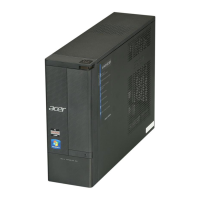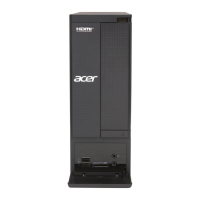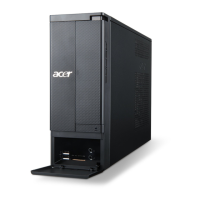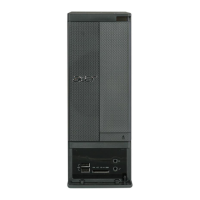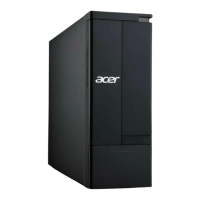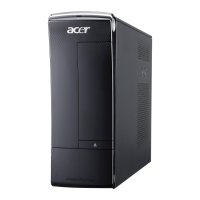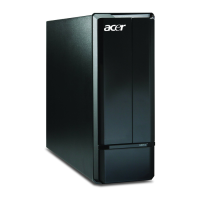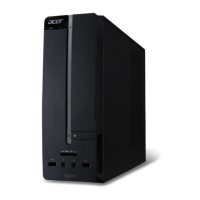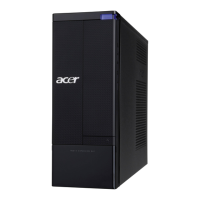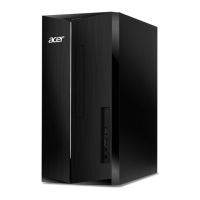Do you have a question about the Acer Aspire X1301 and is the answer not in the manual?
Brief summary of the computer's features, for reference only.
Lists supported AMD Athlon, Phenom, and Sempron processor models.
Specifies the NVIDIA nForce MCP78 chipset.
Details support for DDR2-667 registered ECC modules.
Lists optical drives and hard disk drive specifications.
Describes the integrated Gigabit Ethernet LAN port.
Details external components and ports on the front of the chassis.
Describes the ports and connectors available on the rear of the chassis.
Identifies key internal hardware components of the system.
Explains the meaning of various system status LEDs.
Overview of the BIOS configuration program and its uses.
Step-by-step instructions to access the BIOS setup utility.
Explains keyboard controls for navigating the BIOS setup.
Lists the main BIOS setup menu categories.
Displays system hardware details like processor and BIOS version.
Configuration for system date, time, and memory settings.
Settings for CPU, boot order, and security.
Configuration options related to the motherboard chipset.
Options for configuring system memory timings.
Settings for onboard devices like audio, LAN, and USB.
Options for managing system power saving features.
Monitoring of system temperatures, fan speeds, and voltages.
Procedure to set a supervisor password for BIOS access.
Procedure to set a user password for limited BIOS access.
Saves configuration changes and exits the BIOS setup utility.
Discards changes and exits the BIOS setup utility.
Lists the necessary tools for disassembling the computer.
Steps to perform before starting the disassembly process.
Overview of the component removal sequence with a flowchart.
Step-by-step instructions for removing the system's side panel.
Instructions for safely removing the front bezel.
Guide to removing the CPU heat sink and fan assembly.
Procedure for safely removing the processor unit.
Steps for removing the optical drive from its bay.
Procedure for safely removing the hard disk drive.
Instructions for removing the power supply module.
Guide to removing RAM modules from the motherboard.
Steps for removing an expansion card from a PCI slot.
Instructions to detach front panel connector boards.
Procedure for removing the motherboard from the chassis.
General steps for diagnosing system hardware issues.
Steps for checking power and performing system inspections.
Lists Power-On Self-Test (POST) codes and their meanings.
Details on accessing Acer's online support resources.
Visual representation of system component interconnections.
Diagram showing the location of components on the mainboard.
Explanation of the function and settings of system jumpers.
Illustrated breakdown of system parts with reference numbers.
List of field-replaceable units with part numbers and descriptions.
Detailed specifications for AMD Athlon, Phenom, and Sempron processors.
Identifies key chips on the motherboard, such as core logic and controllers.
Specifications for system RAM modules, including type and speed.
Information about the BIOS vendor, version, and SMBIOS version.
Details on the PCI Express controller and available slots.
Specifications for the LAN controller, protocol support, and connector.
Details on the SATA controller and available ports.
Information about the system's input device controller.
Specifications for the BD-R optical drive.
| Tcase | 69.1 °C |
|---|---|
| Bus type | DMI |
| Stepping | N0 |
| Processor cache | 3 MB |
| Processor model | 620 |
| System bus rate | 5 GT/s |
| Processor family | Intel Pentium G |
| Processor series | Intel Pentium G600 Series for Desktop |
| Processor socket | LGA 1155 (Socket H2) |
| Processor threads | 2 |
| Processor codename | Sandy Bridge |
| Processing Die size | 135 mm² |
| Processor frequency | 2.6 GHz |
| Processor cache type | Smart Cache |
| Processor lithography | 32 nm |
| Processor manufacturer | Intel |
| Processor front side bus | - MHz |
| PCI Express slots version | 2.0 |
| Processor operating modes | 64-bit |
| ECC supported by processor | No |
| Thermal Design Power (TDP) | 65 W |
| CPU multiplier (bus/core ratio) | 26 |
| Memory types supported by processor | DDR3 1066 |
| Number of Processing Die Transistors | 169 M |
| Memory bandwidth supported by processor (max) | 17 GB/s |
| Maximum internal memory supported by processor | 32 GB |
| Memory slots | 2x DIMM |
| Internal memory | 3 GB |
| Memory channels | Double-channel |
| Internal memory type | DDR2-SDRAM |
| Maximum internal memory | 4 GB |
| HDD interface | SATA |
| Optical drive type | DVD-RW |
| Card reader integrated | Yes |
| Total storage capacity | 320 GB |
| Compatible memory cards | CF+, MMC, MS Pro, SD |
| Audio input | 5 |
| Networking features | Gigabit Ethernet |
| Graphics card family | Nvidia |
| Discrete graphics card model | NVIDIA® GeForce® 7100 |
| Maximum graphics card memory | 1.024 GB |
| On-board graphics card model | Intel® HD Graphics |
| On-board graphics card base frequency | 850 MHz |
| On-board graphics card dynamic frequency (max) | 1100 MHz |
| Audio system | HD |
| Product type | PC |
| Audio output channels | 5.1 channels |
| Display diagonal | 19 \ |
| Trial software | McAfee Internet Security Suite 2009 |
| Bundled software | Nero 9 Essentials Adobe Reader CyberLink PowerDVD |
| Operating system installed | Windows 7 Home Premium |
| Serial ports quantity | 0 |
| USB 2.0 ports quantity | 9 |
| Firewire (IEEE 1394) ports | 1 |
| Chassis type | Desktop |
| Product color | Black |
| Certification | FCC, CE, BSMI, CCC, VCCI, CB |
| Processor code | SL8AB |
| Processor ARK ID | 53480 |
| Processor package size | 37.5 mm |
| Supported instruction sets | SSE4.1/4.2 |
| Depth | 352 mm |
|---|---|
| Width | 100 mm |
| Height | 265 mm |
